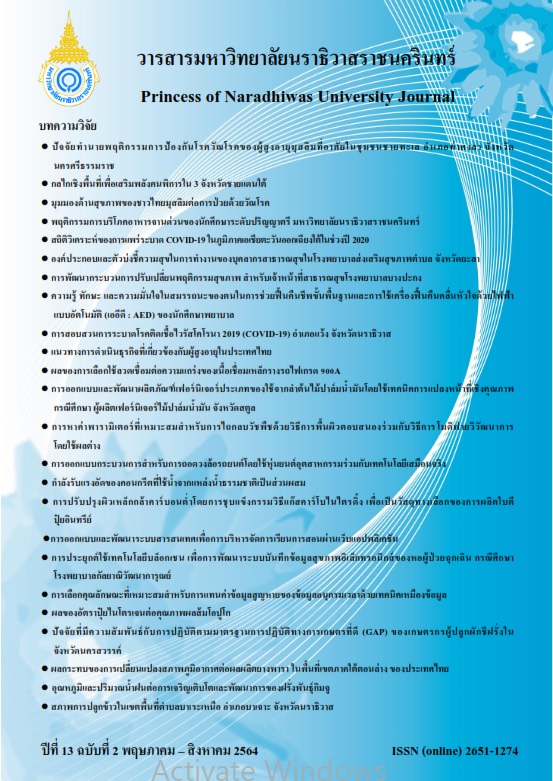Knowledge, Skills and Self-Confidence in Basic Life Support and Automated External Defibrillator (AED) using among under Graduated Nursing Students
Keywords:
basic life support, automated external defibrillator, nursing studentsAbstract
This research is descriptive research aimed at studying the knowledge, skills, and self-confidence in Basic Life Support (BLS) and the use of Automated External Defibrillator (AED) of undergraduate nursing students studying in junior year. 35 participants in the research received BLS and AED training. The tools used to collect data were BLS and AED knowledge and skill tests and a chest compression performance test on a Brayden pro with real-time feedback, which the data were analyzed by descriptive statistics and content analysis. The results revealed that almost all of the participants were female (85.71%) with the average age of 20.94 years (S.D.=0.59). They had received BLS training ( =3.94, S.D.=1.14) and the AED training ( =2.57, S.D.=1.12) but never applied in a real life situation. Their level of self-confidence of BLS and the use of AED were at a moderate level ( =5.69, S.D.=1.02 and =6.31, S.D.=1.30), respectively. Level of knowledge was between a good (42.86%) and an excellence level (25.71%). Level of BLS skill was between a good level (31.43%) and an excellence level (42.86%). Level of the use of AED skill was between a good (54.29%) and an excellence level (34.29%). The performance of chest compression as recommended by the 2015 American Heart Association Guidelines had not reached the standard in the areas of shallow and specified rate of compression, hand placement, full chest recoil and time per one circle. In conclusion, BLS and AED training programs should be initially established in various simulated case scenarios. The programs should be taught by certified BLS instructors and real-time feedback should be provided at training sessions in order to reflect learners’ performance. It could help them to improve their self-confidence.
References
American Heart Association. (2018). Highlights of the 2018 Focused Updates to the American Heart Association Guidelines for CPR and ECC: Advanced Cardiovascular Life Support and Pediatric Advanced Life Support. Heart and Stroke Foundation of Canada Edition.
Bloom, B. S. (1956). Taxonomy of educational objectives (Handbook II: The affective domain). New York: David Mckay.
Bucki, B., et al. (2017). Depth and rate of chest compression in CPR simulation during 10-minute continuous external cardiac compression. Annales Academiae Medicae Silesiensis, 71, 1-6. 10.18794/aams/65226.
Bucki, B., et al. (2019). The assessment of the kinematics of the rescuer in continuous chest compression during a 10-min simulation of cardiopulmonary resuscitation. Eur J Med Res, 24(1), 9.
Chanchayanon, T., Suwanwong, P., & Nimmaanrat, S. (2011). Outcome of In-Hospital Cardiopulmonary Resuscitation and Factors Affecting the Outcome at Songklanagarind Hospital. Songkla Med J, 29(1).
Dal, U., & Sarpkaya, D. (2013). Knowledge and psychomotor skills of nursing students in North Cyprus in the area of cardiopulmonary resuscitation. Pak J Med Sci, 29(4), 966-971.
Huang, Y., He, Q., Yang, L. J., Liu, G. J., & Jones, A. (2014). Cardiopulmonary resuscitation (CPR) plus delayed defibrillation versus immediate defibrillation for out-of-hospital cardiac arrest. The Cochrane database of systematic reviews, 2014(9), CD009803. https://doi.org/10.1002 /14651858.CD009803.pub2
Kuhakan, R., Chusaeng, S., Somton, A., Suwannaruk, U., & Suwannaruk, S. (2017) Annual report 2016. National Institute for Emergency Medicine. Retrieved January 10, 2020 from https://www.niems.go.th/1/Ebook/Detail/777?group=21
Kumkong, M., Leejareon, P., Aramrom, Y., & Jitviboon A. (2016). Effects of Simulation-Based Learning on Perceived Self-Efficacy in Providing Nursing Care for Advanced Life Support to Patients with Critical Illness or Emergency Condition among Nursing Students. The Southern College Network Journal of Nursing and Public Health. 3(3).
Majer, J., Madziala, A., Dabrowska, A., & Dabrowski, M. (2018). The place of true CPR feedback device in cardiopulmonary resuscitation Should we use it? A randomized pilot study. Disaster Emerg Med J, 3(4), 131-6.
Meier, P., et al. (2010). Chest compressions before defibrillation for out-of-hospital cardiac arrest: a meta-analysis of randomized controlled clinical trials. BMC medicine, 8, 52. https://doi.org/10.1186/1741-7015-8-52
Ministry of Public Health. (2019). Public Health Statistics A.D. 2018. Retrieved January 10, 2020 from http://planning.anamai.moph.go.th/download/D_DataMarts/Stat/health_ statistics%2061.pdf
Neumar, R.W. et al. (2015). Part 1: Executive summary: 2015 American heart association guidelines update for cardiopulmonary resuscitation and emergency cardiovascular care. Circulation. 132(18 Suppl 2): S315-67.
Norkaeo, D., Treenon, P., Chabuakamม N., Kanbupar, N., Teanthong, S., & Kaewmanee, C. (2018). Nursing Students Knowledge and Skills about Basic Life Support (BLS): The Effects of Simulation-Based Learning. The Southern College Network Journal of Nursing and Public Health, 5(3).
Ogilvie, S., Cragg, B., & Foulds, B. (2011). Perceptions of Nursing Students on the Process and Outcomes of a Simulation Experience. Nurse Education, 36(2), 56–58.
Partiprajak, S. (2015). Relationship between Knowledge, Perceived Self-efficacy in Basic Life Support (BLS), and Chest Compression Performance among Undergraduate Nursing Students. Songklanagarind Journal of Nursing, 35(1).
Roh, Y. S., & Issenberg, S. B. (2013). Association of cardiopulmonary resuscitation psychomotor skills with knowledge and self-efficacy in nursing students. International Journal of Nursing Practice. Retrieved January 2, 2020 from http://onlinelibrary.wiley. m/doi/10.1111/ijn.12212 /pdf
Sinthuchai, S., Ubolwan, K., & Boonsin S. (2017). Effects of High-Fidelity Simulation-Based Learning on Knowledge, Satisfaction, and Self-Confidence among the Fourth Year Nursing Students in Comprehensive Nursing Care Practicum. Rama Nurs J, 23(1).
Smith, K., Gilcreast, D., & Pierce, K. (2008). Evaluation of Staff’s Retention of ACLS and BLS Skill. Resuscitation, 78(1), 59-65.
Sullivan, N.J., et al. (2014). Simulation exercise to improve retention of cardiopulmonary resuscitation priorities for in-hospital cardiac arrests: A randomized controlled trial. Resuscitation. 86:6-13.
Thongpo, P., & Udomchaikul, K. (2020). Effects of a Cardiopulmonary Resuscitation Training Program on Knowledge, Perceived Self-efficacy in Cardiopulmonary Resuscitation, and Chest Compression Performance among Nursing Students. Rama Nurs J, 26(1), 107-121.
Toubasi, S., Alosta, R. M., Darawad, W. M. & Demeh, W. (2015). Impact of Simulation Training on Jordanian Nurses’ Performance of Basic Life Support Skill: A Pilot Study. Nurse Education Today, 35(9), 999-1003.




